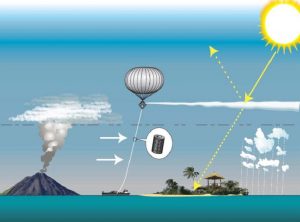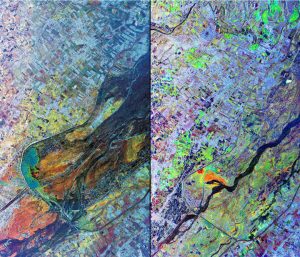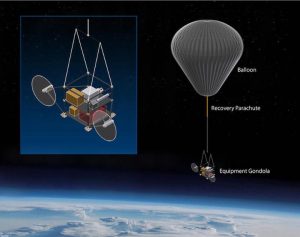These are the words of UN Secretary-General António Guterres at the COP28 climate conference in Dubai in November-December 2023. At this point, it should not be necessary to stress the severity of the impacts of climate change that we are already experiencing today. We are in a race against time to avoid catastrophe. And in this race, every idea is worth considering, even the most audacious: cooling the Earth by reducing the solar radiation passing through the atmosphere on a planetary scale.
Geoengineering to combat climate change has been on the drawing boards of experts for decades. In its most basic form, the idea is to remove greenhouse gases from Earth’s atmosphere, for example by sequestering CO2 in the Earth’s interior. A second, more ambitious option is to shield Earth from the Sun’s rays to compensate for global warming, like putting an umbrella over the planet.

Of course, such a radical proposal requires extensive and in-depth studies to ensure that artificial weather modification does not in itself produce disastrous consequences. For this reason, climate engineering has been a controversial discipline since its inception. While many experts are in favour of geoengineering research, there are still serious questions about which approaches merit further study.
The most concrete idea currently under discussion is to disperse particulate aerosols in the atmosphere in order to reduce the solar radiation striking Earth’s surface. Various proposals have been put forward as to the nature of these particles, such as micro-droplets of seawater, ice crystals or even alumina and diamond dust.
The solution that has attracted the most interest in recent years is the dispersion of sulphate aerosols, a process that aims to mimic the effect of large volcanic eruptions. In the past, such natural phenomena have temporarily altered the global climate, the most famous case being the “year without a summer” of 1816, caused mainly by the eruption of the Tambora volcano in Indonesia.
Side Efects
But there are serious concerns about the proposal. Experts say it could dangerously alter global rainfall patterns and damage the ozone layer due to the sulphuric acid formed. In 2018, a study published in Nature analysed natural experiments from past volcanic eruptions to determine their impact on agriculture. And while a reduction in warming alleviates heat stress on crops, the results showed that a reduction in sunlight negatively affects growth.
For example, the 1991 eruption of Mount Pinatubo in the Philippines injected some 20 million tonnes of sulphur dioxide into the atmosphere, reducing sunlight by 2.5% and lowering global temperatures by half a degree Celsius. Looking at global production of wheat, rice, maize and soybeans in 105 countries between 1979 and 2009, along with satellite observations of the aerosols dispersed by the eruption and in the context of global climate models, the researchers found that the cooling did not lead to increased yields.

“Our paper found that, for agricultural productivity, the potential benefits of solar geoengineering from reducing temperatures would be offset by damages from reductions in sunlight,” the study’s lead author, Jonathan Proctor of the University of California at Berkeley, told OpenMind. “So on net there would be no benefit to agriculture.” Proctor added that other sectors of the economy could be affected, but the problem is that it is not yet known in what way: “They could potentially benefit substantially or be substantially damaged, we just don’t know.”
However, Proctor felt that his results did not suggest that solar geoengineering should be completely ruled out, but rather that the options available should be assessed with extreme caution. “Optimising the radiative properties of particles used might be able to mitigate sunlight-mediated damages,” he said.
In 2023, another modelling study found that the impact of any aerosol dispersion in the atmosphere on maize, rice, soybean and wheat harvests would vary in different parts of the world: a strong intervention would help production in the equatorial region, while a more moderate intervention would be more advantageous for mid-latitudes, while countries further away from the equator would benefit from climate change without this brake. In other words, there is no “one size fits all” optimal strategy for the entire planet.

This search for optimisation is the aim of scientists such as University of Chicago physicist David Keith, one of the most visible proponents of solar radiation management. According to Keith, “some of the problems identified in earlier studies where solar geo-engineering offset all warming are examples of the old adage that the dose makes the poison.”
Keith’s proposal does not seek to offset global warming entirely, but only to halve the temperature increase due to greenhouse gases. Calculations by Keith and his collaborators show that this formula would avoid drastic changes in temperature and precipitation, moderate the intensity of tropical cyclones by 85% and limit the potential negative effects to less than 0.4% of Earth’s surface, in places that have suffered less from the scourge of climate change. According to the study’s lead author, Peter Irvine, the result is “a large overall reduction in climate risk without significantly increasing risk in any region.”
FROM COMPUTER MODELS TO THE REAL WORLD
These predictions may soon be confirmed. Keith was one of the people at Harvard University responsible for the Stratospheric Controlled Perturbation Experiment (SCoPEx), a project that has yet to be completed. SCoPEx will use a balloon equipped with propellers to disperse aerosols over a sector of sky one kilometre long and 100 metres wide, at an altitude of 20 kilometres, for at least 24 hours. Particles of an ozone-friendly material will be used: calcium carbonate, the same material that forms limestone rock, seashells and eggshells, and which is also used as a digestive antacid. Instruments on the balloon will measure changes in atmospheric chemistry and the scattering of sunlight.

However, initial plans for this proof of concept in 2019 did not materialise and have since been postponed indefinitely. A plan to carry it out in Sweden was halted by the Swedish government after pressure from local communities and environmental organisations, and SCoPEX is still waiting for the green light. In the words of the experiment’s director, atmospheric scientist Frank Keutsch, “we should never choose ignorance over knowledge.” But others have already taken the plunge: in 2022, the US company Make Sunsets spread sulphur dioxide in the skies over Baja California without the permission of the Mexican government, which responded by banning such experiments. Another option, being tested on a small scale on Australia’s Great Barrier Reef, is to spray seawater with cannons to create whiter, denser clouds to protect corals from excessive warming of the water.
At an even more theoretical level, there are other, bolder ideas. In 1989, the physicist and engineer James Early of the Lawrence Livermore National Laboratory first proposed placing a shield to block solar radiation at the first Lagrange point (L1), one of the five points of stable equilibrium in the gravitational system formed by the Earth and the Sun. Early’s imagined shield, made of thin glass constructed from lunar materials, seemed more science fiction than reality, but the gauntlet was taken up by other scientists. Suggestions include building a giant 35,000-tonne umbrella or using trillions of tiny discs. There is even a foundation dedicated to researching the concept.

As scientists continue to raise the possibilities, there is an ongoing debate about whether to go down this road, with some in the scientific community supporting it and others rejecting it outright. But the odds are currently in favour of keeping it on the table and under the research microscope. In 2021, the US National Academies of Sciences, Medicine and Engineering recommended that the US government invest $200 million in a research programme. In June 2023, a White House report expressed support for such studies. The European Union, for its part, encourages discussion and research, but warns of the serious risks involved and does not endorse the development or testing of these techniques.
Despite all this, and the disagreements between experts, there is one thing on which there is agreement. In the words of Douglas MacMartin, a geoengineering researcher at Cornell University, “these ideas should only be considered as an additional component of our response to climate change, not as a substitute for cutting emissions.”
Comments on this publication